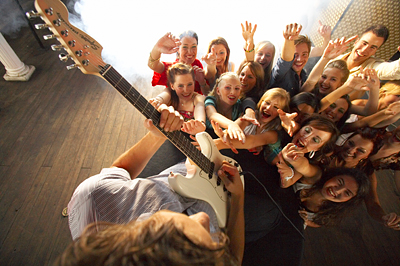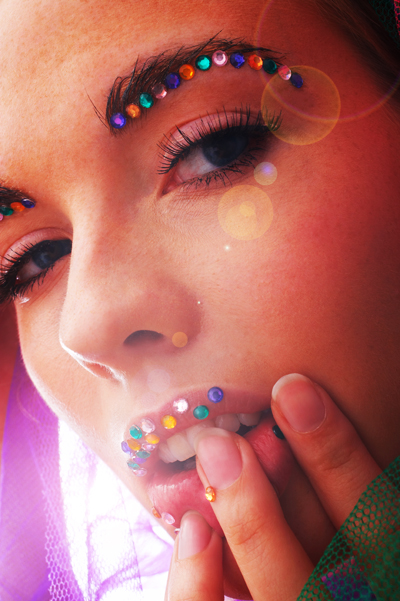Eight Secrets from the World’s Top Selling Photographer
Posted Thursday, 13 September 2007 by Yuri Arcurs in
Photography,
Inspiration
You don't have to be a pro to take photos like a pro – we here at Crestock.com convinced the world’s top selling stock photographer, Yuri Arcurs, to share with us his top 8 secrets – a clear-cut guide to being successful as a photographer
1. Learn to see and frame your pictures in perceptual layers
What does this mean? A camera will only focus on one item; the elements behind and in front of this item can be viewed as layers: Foreground(s), focal point and background layer(s).
The relationships between these layers are often what makes pictures interesting. If you look at prize-winning photojournalistic images, you will see a striking similarity; All the layers intervene perfectly and in some way or another complete or add to the feeling or idea of the picture.
Great pictures have many layers and they “speak” together. When shooting real-life photojournalism, this is one of the hardest aspects to master and really demands multitasking.
When shooting commercial photography, thinking in layers can be used as a tool to complete the image. The background layer is often neglected by amateur photographers or is entirely missing – but by building up your layers step by step you can often gain a competitive advantage over other photographers.

 Notice how the first picture looks like a real concert, then take a look at the technical photo below it. It is not a concert, and only 23 models where present, but by being careful with foreground and background layers, the final shoot looks just like a real concert.
Notice how the first picture looks like a real concert, then take a look at the technical photo below it. It is not a concert, and only 23 models where present, but by being careful with foreground and background layers, the final shoot looks just like a real concert.2. Think “icon”
Will the image you have in mind still function when viewed at the size of a small icon or if only viewed for a quarter of a second? Can you still decipher what’s happening in the picture?
Great commercial shots have this characteristic and use different lighting and colours to create contrasts between the elements of the image.
In today’s fast moving everyday life, you need to create images that go straight for the point. In stock photography, the “icon effect” is the essence of how to make your pictures stand out. Too many obstacles and confusing design elements will greatly reduce the “icon effect”.
Choose with great care what you want in your foreground and background layers so it doesn’t become messy.

 Here is an example of how we edit our pictures. Notice how taking away a lot of distracting elements makes the icon effect so much stronger.
Here is an example of how we edit our pictures. Notice how taking away a lot of distracting elements makes the icon effect so much stronger.3. Use stereotypes to strengthen your point
While reading the next few lines, try to do exactly what I tell you, and promise to really do this or you will miss the point. Only using your head, calculate 6x6, add 14 then subtract 50. Are you following? If not then calculate...
Now think of a hand tool. Picture it in your head. Then think of a color. Close your eyes and picture this color in your head too.
Now if you belong to 95% of the normal population, you would have thought of a hammer and the color red. This is because the hammer and the color red are stereotypical members of the categories of “hand tools” and “colors”.
Use knowledge like this to strengthen your “Icon effect”. If people only have a split-second of viewing, be wise and use stereotypes so people can easily identify the elements of the picture. Identifying stereotypes doesn’t have to be harder than using common sense.
In the category of 'classic female beauty' for example, Marilyn Monroe would probably be a good candidate for a stereotype, except she is pretty hard to get photos of, but you get the point.
 The color of this guitar was chosen with great care. If it had been black or any other darker colour, it would simply have disappeared in the crowd. Choosing a white guitar makes it stand out and become iconic – even as a small preview it is pretty clear what this picture is about.
The color of this guitar was chosen with great care. If it had been black or any other darker colour, it would simply have disappeared in the crowd. Choosing a white guitar makes it stand out and become iconic – even as a small preview it is pretty clear what this picture is about.4. Take advantage of basic human nature
If I have a really high-demanding client that I want to impress, I use a bit of my background in psychology to analyse my way to a safe hit. People in general tend to like one or more of three things in a picture; humour, extraordinary things, and contrasting symbolism.
Contrasting symbolism is when two opposites clash and create irony; A priest shoplifting, or a skinny man besides a fat man. It is basic, but it works – anything that tells a story about the irony and diversity of everyday life. Try to picture a photo you like that does not have one or more of the above features.
Features like contrasting symbolism require thinking and planning but if you succeed it will become a real eye-catcher. By extraordinary, think mystique, strangeness and curious pictures. Sometimes at a shoot I can hear myself tell my stylist things like “this setup is not strange enough, make it weirder”
The human being is enchanted by things of the extraordinary, so twist, bend, and weirden-up reality for a sure hit.
 Notice the mystique and feel to this picture.
Notice the mystique and feel to this picture.5. Stay away from conservative composition
Technically speaking, the schoolbook composition rules will tell you to keep composition conservative, not to cut the forehead in portraits, only take standard pictures with all parts of the image elements inside the frame and such – what a bore! Don’t listen to such nonsense!
Every single one of my most successful pictures are composed directly opposite of textbook composition rules and are often cropped. Experiment! Shoot from above, from below and stick to a natural gut feeling when composing your frames instead of rules.
Over the years your sense of composition grows and you will gradually master it in your own way by adding a personal signature to all your pictures.
 This photo has lens flare and a composition that would make a newly trained image inspector/reviewer scream. It also has blown-highlights, tilted horizon and only focus on one pair of eyes. The head of the young man is cropped. In many ways this pictures is “text-book crap” but it is nevertheless a lot more interesting than all the basic stuff.
This photo has lens flare and a composition that would make a newly trained image inspector/reviewer scream. It also has blown-highlights, tilted horizon and only focus on one pair of eyes. The head of the young man is cropped. In many ways this pictures is “text-book crap” but it is nevertheless a lot more interesting than all the basic stuff.6. Instruct and say “stop”
Instruction is everything! If the model doesn’t know what you want from your shoot/scene then he/she simply will not provide it. Most good models know their best angle and poses and will start posing as soon as they see a camera. Stop this posing roller coaster and engage the model in the situation and make them look human!
When shooting more than one person, you should try to engage the people in conversation and real interaction and tell them “STOP” when you want the picture taken. This method is great for getting non-artificial looking pictures that feel like you were never there.
When doing business shoots or staff portraits I often engage my models in games such as writing a story together; the first person writes one or two lines, the next a few lines more, and suddenly they are having fun and are relaxing and great picture opportunities arrive.
7. Be overly productive
My senior assistant, who is a photojournalist, came up to me the other day after doing a backstage report for a Danish rock band and said: “I don’t get it at all…all these other photographers were just sitting around with their cameras and talking…and I know this for a fact because I saw them doing it through my viewfinder”.
My assistant saw this whole concert through his camera and took over 1300 RAW files in three hours with his 1Ds. I don’t care how much talent one has; it takes pictures – and a lot of them – to get great shots.
Shoot like crazy, especially if you have a limited time with the models or at the location.On a good day of shooting stock photography I am sometimes able to get a conversion rate of about 3-4% of my RAWs that convert to end product pictures.
Using percentages to calculate how many RAWs convert into end product pictures is very smart because it leads you to accept one very convincing conclusion; that more RAWs converts into more end product pictures.
This deduction is naively simple and could be objected to in many ways, but it does have some degree of inevitable truth; Sitting around and talking, or being unproductive at a shoot, you can be sure to miss that window of opportunity holding the hit picture – go get shooting and produce like crazy!
8. Don’t ever settle for less

 Here you see a crop of one of my standard studio shoots. You don’t need to oversharpen your pictures, creating artifacts to make them look sharp (providing you use high-quality lenses). This crop is unsharpened, camera setting: zero and developer setting: Zero. There is plenty of resolution and capability in a normal 1Ds Mark II, no need for medium format.
Here you see a crop of one of my standard studio shoots. You don’t need to oversharpen your pictures, creating artifacts to make them look sharp (providing you use high-quality lenses). This crop is unsharpened, camera setting: zero and developer setting: Zero. There is plenty of resolution and capability in a normal 1Ds Mark II, no need for medium format.Most photographers who were educated to shoot analogue have shifted to digital, but have done this shift of workflow with no or hardly any digital education or knowledge.
Now this troubles me a bit because a lot of these photographers have very high thoughts about themselves, but really know absolutely nothing about digital workflow and are too proud and “artistic” to care about phenomena like artifacts, banding, tiff files – you name it.
Make it a personal choice not to associate or be part of a photographic environment made up of people like that. Get your digital training from online sources that are up to date.
Within a few years from now, digital standards will rise a lot and then you will be prepared. Go the extra mile and educate yourself using resources such as
Lynda.com – and my homepage:
www.arcurs.com:)
All content is copyrighted Yuri Arcurs, do not reprint or use without credits and link to www.arcurs.com Related posts:
» Top 5 Must-Read Photography Blogs» 10 Reasons Why Your Stock Photographs Are Rejected» How to Successfully Launch a Freelance Career» Top 10 Pro Stock-Photography Tips